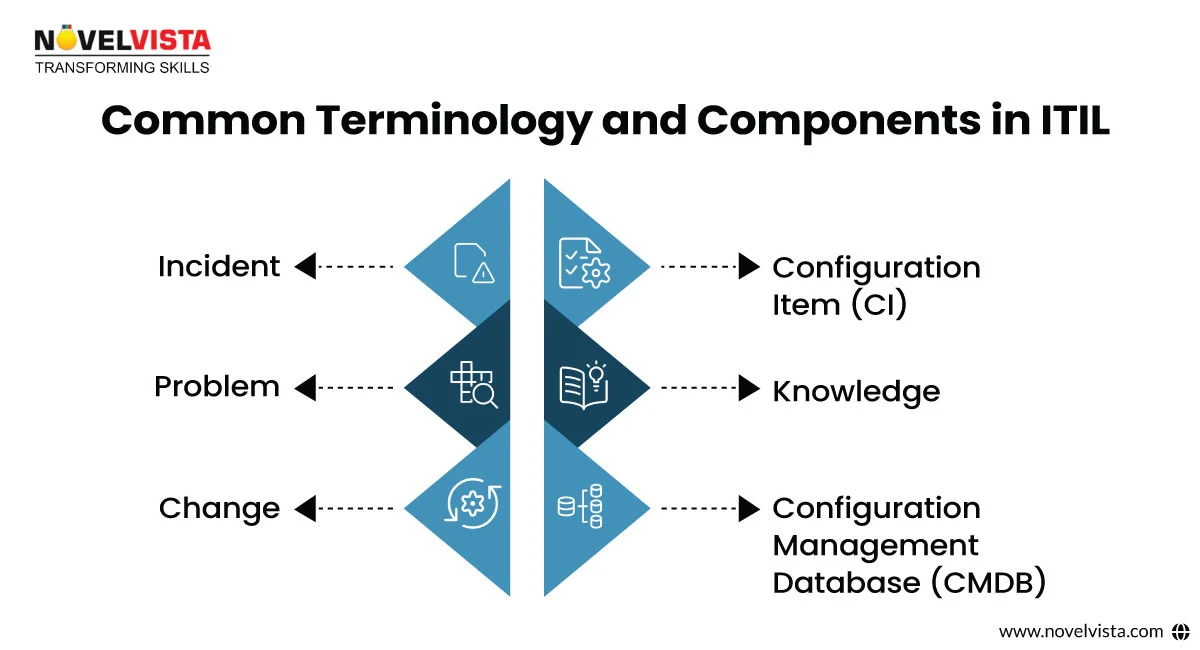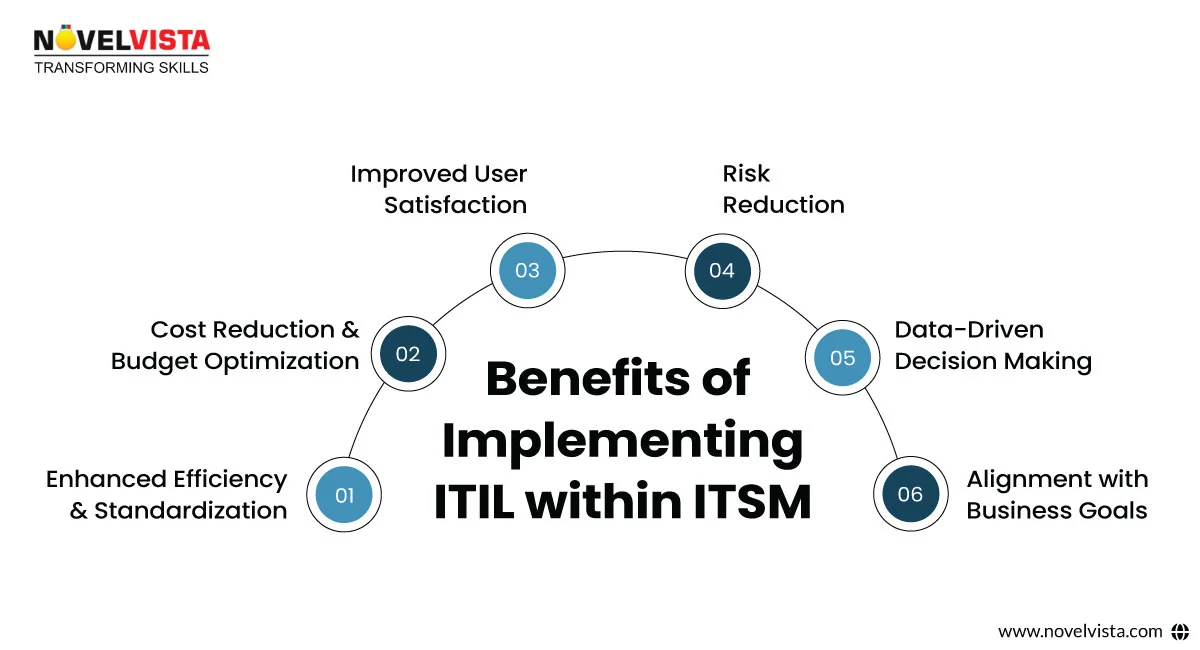In today’s fast-paced digital business environment, ITIL usually aligns with ITSM, yet they’re not the same thing. It’s essential to distinguish the two for better implementation, strategy, and outcome
Organizations utilize ITIL and ITSM best practices to accomplish business process improvement, manage expenses, and improve efficiencies inside the association. ITIL is a set of processes and standards to assist organizations in practicing IT Service Management successfully.
As organizations change their plans of action and business procedures to contend in a computerized economy, IT service management and ITSM best practices like ITIL are changing alongside them. CIOs are adjusting ITIL and ITSM best practices to work in cloud computing - the best choice of today’s world. IT businesses are exploring different noo and corners of modern technologies regarding AI innovations. As an example,they are using Machine learning and virtual assistants to improve and robotize numerous parts of ITSM that were recently done physically. Moreover, departments like financial, legal and Human Resources are consulting with IT in order to utilize ITSM and ITIL procedures to improve their work processes.
ITSM stands for IT Service Management, a strategic approach to designing, delivering, managing, and improving how IT is used within an organization. Rather than focusing solely on technology, ITSM emphasizes delivering value to customers through clearly defined services. In simple terms, ITSM is the “what” of IT services.
On the other hand, the ITIL framework (Information Technology Infrastructure Library) offers a set of detailed practices for ITSM that focus on aligning IT services with business needs. It provides guidance for establishing governance, service design, transition, and continuous improvement.
Here's a clear-cut analogy: If ITSM is the "destination," then ITIL is the "map" to get there. ITSM is the broad concept, and ITIL is one of the best-known frameworks (among others like COBIT, MOF) that help organizations manage ITSM successfully.
ITSM vs ITIL comparisons are common among organizations just starting their digital transformation. While ITSM defines the structure of IT services, ITIL outlines how to improve and execute those services efficiently.
The roots of ITIL go back to the 1980s, when the UK government realized its public-sector IT services lacked consistency and cost-effectiveness. The Central Computer and Telecommunications Agency (CCTA) responded with ITIL as a means to standardize service management.
The original ITIL volumes were comprehensive but scattered across numerous books. By the time ITIL V2 was released, it offered a more structured approach, particularly around service support and delivery. Then came ITIL V3 in 2007, introducing the concept of a service lifecycle, aligning even more closely with business objectives.
Fast forward to 2019, the release of ITIL4 marked a significant shift. It introduced a more flexible, agile, and collaborative approach, incorporating Lean, Agile, and DevOps principles. This evolution enabled ITIL to stay relevant in the age of cloud computing, automation, and cross-functional teams—making it more aligned than ever with modern ITSM best practices.
Today, ITIL as well as ITSM are inseparable pillars in achieving digital maturity and operational excellence.
To successfully implement ITIL, it’s crucial to be familiar with core terminologies and their roles within the system. These components work in harmony to deliver IT services that meet both technical and business expectations.

ITIL’s magic lies in its ability to create a holistic, well-defined process through its five lifecycle stages. These stages form the backbone of effective ITIL and ITSM implementations and help deliver high-quality IT services that align with business goals.
1. Service Strategy
This phase focuses on defining services as strategic assets. It includes market analysis, service portfolio management, financial management, and demand forecasting. The aim is to create value through services.
2. Service Design
In this phase, strategic plans are turned into a blueprint for delivery. It includes service level management, availability, capacity, IT security, and supplier management. Efficient project planning begins here to ensure seamless execution.
3. Service Transition
This is where new or modified services are built, tested, and deployed into the live environment. Emphasis is placed on on-time project delivery, managing risk, and establishing smooth transitions using change management and release processes.
4. Service Operation
This stage ensures day-to-day operations are managed efficiently. It includes key functions like incident management, problem management, and request fulfillment. Here, ITSM software tools play a vital role in service desk operations and monitoring.
5. Continual Service Improvement (CSI)
CSI spans across all stages, driving ongoing improvements by measuring performance, reviewing processes, and implementing enhancements. It ensures that IT services adapt and evolve as business requirements change.
Implementing ITIL practices with ITSM can significantly boost the performance and maturity of IT operations. These benefits go far beyond simple task automation—they help organizations transform IT from a support function to a strategic business partner.

1. Enhanced Efficiency and Standardization
When IT teams follow ITIL best practices, they gain a structured approach to service delivery. This reduces ambiguity, eliminates duplicated efforts, and improves collaboration across departments. With pre-defined workflows and templates, organizations can operate more predictably and respond to changes faster.
2. Cost Reduction and Budget Optimization
By identifying inefficiencies and overused resources, ITIL helps in reducing operational costs. For example, Configuration Management Database (CMDB) ensures IT assets are fully utilized and not duplicated unnecessarily, which directly impacts ROI.
3. Improved User Satisfaction
Consistent service levels, timely resolutions, and proactive support greatly improve the user experience. The integration of ITIL roles and responsibilities ensures accountability and clear ownership at every service stage.
4. Risk Reduction
The ITIL Change Management process minimizes disruption and risk by enforcing impact assessments and testing procedures before changes are implemented. This builds resilience into systems and helps organizations maintain continuity even during transitions.
5. Data-Driven Decision Making
ITIL promotes continual service improvement through metrics and reporting. IT teams can make informed decisions based on performance data, user feedback, and SLA adherence.
6. Alignment with Business Goals
Using ITIL within ITSM ensures IT services are aligned with business needs. Processes like Service Portfolio Management and Demand Management provide a direct link between IT capabilities and business outcomes.
With the rise of cloud computing, AI, and hybrid work models, traditional IT management is no longer sufficient. Modern organizations require agile, scalable solutions that align IT with business outcomes—and that's where ITIL, as well as ITSM, shine.
Whether you're managing a small in-house IT team or a complex, multi-tiered digital infrastructure, aligning with the ITIL certification path brings structure and strategy to your operations. IT professionals looking to deepen their expertise often start with the ITIL® 4 Foundation Certification Training Course or pair their learning with process-specific programs like the ITSM - ISO/IEC 20000 Foundation Training & Certification.
With platforms like NovelVista, you can access top-tier courses to stay ahead of the evolving IT landscape and become a leader in ITSM best practices implementation.
Introduced in the 1980s, ITIL is a series of core books that give direction to improving the quality and adequacy of IT administrations. Organizations that utilization the ITIL procedures and best practices normally observe an improvement in consumer loyalty and profitability, yet the system can appear to be theoretical and the use of ITIL forms has demonstrated amazingly stimulating for some IT organizations.
ITIL 4 was developed in January 2019 and this section introduces us to the adaptations the new version handles to accommodate today's IT organizations. It also involves a downloadable chapter excerpt fromITIL 4 -- A Pocket Guide.
The IT businesses command to furnish the business with high-caliber, solid IT services continue as usual today as when the CIO job was imagined. What's changing drastically are the technologies and approaches used to convey those administrations and client requests. IT specialists and professionals dive into how ITSM best practices and tools are advancing to serve the present quick moving computerized undertaking.
Maybe more than some other part of ITSM, the conventional service desk area is experiencing quick change. Intelligent AI applications like chatbots, virtual assistants are serving customer needs in behalf of IT staff, and service desk workflow is being embraced by business divisions.
The best practices of Artificial Intelligence such as Machine Learning and natural language processing are being consolidated into ITSM processes. It's still just a beginning for ITSM vendors in this field, so CIOs must be ready to do hands-on testing of AI-imbued ITSM. Yet, as our setup of pattern stories, expert opinions and uses cases in this segment clarifies, AI is opening up new and energizing approaches to automate IT Service Management, help administration levels, and improve client assistance.
With the dramatic change of IT Service Management, ITIL and ITSM best practices play the role of protagonists in this huge turnover. If you have recently seen some of the best ITSM Practices that amazed you, don’t forget to let us know in the comment section below!
Discover how ITIL certifications can transform your approach to process improvement.
The evolution of ITIL and ITSM marks a critical shift in how businesses operate in the digital age. With increased demand for seamless services, automation, and user satisfaction, implementing the right project execution strategy is non-negotiable. IT teams must be equipped with not just tools but also frameworks and standards that ensure efficiency, resilience, and strategic alignment.
If you're still wondering whether to go with ITIL or ITSM, the answer is: both. One complements the other. They work best when integrated—because successful IT management isn’t about choosing sides; it’s about building synergy.
Confused about our certifications?
Let Our Advisor Guide You